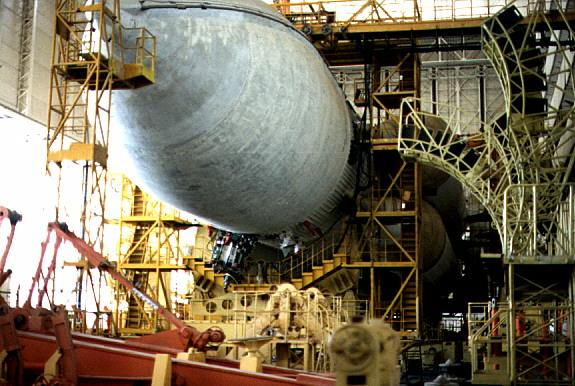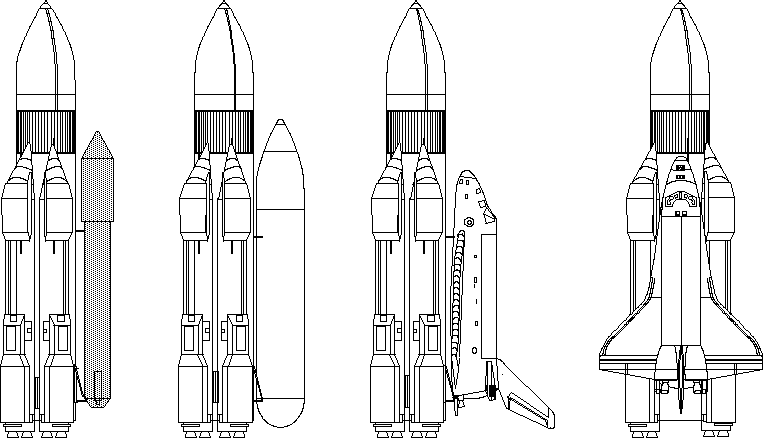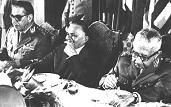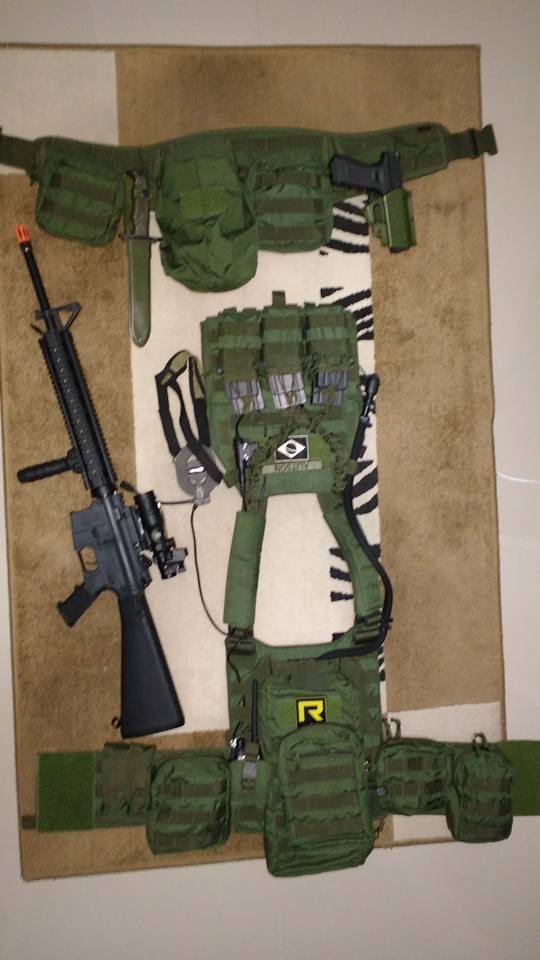
Orbital launch vehicle. Family: Energia. Country: Russia. Status: Hardware. Library of Congress Designation: J. Department of Defence Designation: SL-17. Article Number: 11K25.
The Energia-Buran Reusable Space System (MKS) was developed as a system that would duplicate the capabilities of the US shuttle system. This decision was taken on 12 February 1976 by the Soviet leadership (Brezhnev, Ustinov, Keldysh) following the loss of the moon race to America. This had pointed to serious deficiencies in the technology base of the Soviet Union. The time-honoured Soviet method of rectifying such situations was to copy the foreign technology. The Buran decision was contrary to the opinions of the Soviet Chief Designers, who favoured smaller reusable ballistic capsules or spaceplanes, and the Soviet military, which preferred a new family of modular, lower-tech, expendable launch vehicles.
Following extended development, Buran made a remarkably successful first unmanned flight on 15 November 1988, four years late to schedule. But the it would never fly again. The Soviet Union was crumbling, and the ambitious plans to build an orbiting defence shield, to renew the ozone layer, dispose of nuclear waste, illuminate polar cities, colonise the moon and Mars, were not to be. Funding dried up and the Buran program completely disappeared from the government's budget after 1993.
The Energia-Buran Reusable Space System (MKS) had its origins in NPO Energia studies of 1974 to 1975 for a 'Space Rocket Complex Program'. In 1974 the N1-L3 heavy lunar launch vehicle project was cancelled and Glushko was appointed chief designer of the new NPO Energia enterprise, replacing Mishin as the head of the former OKB-1. At the same time in the United States development work was underway on the space shuttle. The US Defence Department planned to use the shuttle for a range of military missions. The Soviet military, seeking strategic parity, wished development in the Soviet Union of a reusable manned spacecraft with analogous tactical-technical characteristics. The success of Apollo and the failure of the N1-L3 program pointed to serious deficiencies in the technology base of the Soviet Union. The time-honoured Soviet method of rectifying such situations was to copy the foreign technology.
The American shuttle design was studied intensively by Russian rocket scientists, but important aspects of it were rejected based on Soviet engineering analysis and technology:
The Soviet Union at this point had no experience in production of large solid rocket motors, especially segmented solid rocket motors of the type used on the shuttle. Glushko favoured a launch vehicle with parallel liquid propellant boosters. These would use a 700 tonne thrust four-chamber Lox/Kerosene engine already under development.
The high chamber pressure, closed-cycle, reusable 230 tonne thrust Lox/LH2 main engine being developed for the shuttle was well outside engineering experience in the Soviet Union. No engine using these cryogenic propellants had ever been used in Russian rockets, and the largest such engine under development was the 40 tonne thrust 11D57. Glushko believed that while a Soviet cryogenic engine of 200 tonnes thrust could be developed in the required time, to develop a reusable engine would be impossible due to limited experience with the propellants.
This conclusion led to other important design decisions. If only expendable engines were to be used, there was no need to house them in the re-entry vehicle for recovery. This meant that the orbiter itself could be moved from the lateral mounting of the space shuttle to an on-axis position at the top of the rocket core. The result was the Vulkan - a classic Soviet launch vehicle design: booster stages arranged around a core vehicle, with the payload mounted on top. The elimination of the lateral loads resulted in a lighter booster, and one that was much more flexible. The vehicle could be customised for a wide range of payloads by the use of from two to eight booster stages around a core equipped with from one to four modular main engines. Either a payload container for heavy payloads (Glushko's LEK lunar base) or the military's required spaceplane could be placed on the nose as the payload.
As far as the manned orbital vehicle itself, three different primary configurations were studied extensively, as well as a range of more radical proposals. The final choice was a straight aerodynamic copy of the US shuttle.
The government decree 132-51 authorising development of the Energia-Buran system was issued on 12 February 1976 with the title 'On development of an MKS (reusable space system) consisting of rocket stages, orbiter aircraft, inter-orbital tug, guidance systems, launch and landing facilities, assembly and repair facilities, and other associated facilities, with the objective of placing in a 200 km Northeast orbit a payload of 30 tonnes and returning a payload of 20 tonnes'. The Ministry of Defence was named the Program Manager, with NPO Energia as the prime contractor. The official military specification (TTZ) was issued at the same time with the code name Buran (the name Energia for the launch vehicle separately did not come into use until just before the launch). A declaration of the Presidium on 18 December 1976 directed co-operation between all concerned user, research, and factory organisations in realising the project. Chief Constructor within NPO Energia was I N Sadovskiy. Chief Designer for the launch vehicle was Y P Kolyako and for the orbiter P V Tsybin. NPO Yuzhnoye in the Ukraine would build the booster rockets.
The Vulkan was used as a starting point, but modified to meet this requirement. Wind tunnel tests were conducted on a wide range of possible arrangements of rocket stages and orbiter positions. In the end, Buran was moved to the lateral position, as with the US space shuttle. The main engines, for the reasons given earlier, remained in the core vehicle. The liquid boosters were retained, but reduced to four in number. After being re-stressed for the lateral launch loads, the resulting Energia launch vehicle had half the lift-off mass and payload of the Vulkan. This was sufficient to carry the Buran with its required internal payload of 30 tonnes.
The MKS draft project was completed on 12 December 1976. The military assigned the system the index number 1K11K25 and the launch vehicle the article number 11K25. The draft project was reviewed by the expert commission in July 1977, leading to a government decree 1006-323 of 21 November 1977 setting out the development plan. The technical project was completed in May 1978. The flight test plan at the beginning of the project foresaw first launch of the booster in 1983, with the payload being an unmanned OK-ML-1 mock-up of the orbiter. This would not have a heat shield and remain attached to the booster. A second mock-up, OK-ML-2, would be used on the second launch, but be separated from the vehicle after burnout. However it would also be without heat shield, and be expended. The first flight Buran was to fly unpiloted in 1984. Manned flights were to be routine by the 1987 seventieth anniversary of the Soviet Union.
The approved launch vehicle layout consisted of the core Block Ts stage, surrounded by 4 Block A liquid propellant boosters and the Buran orbiter or a payload canister. During assembly, transport, and on the pad these were attached to a Block Ya launch services module, which provided all pneumatic, electrical, hydraulic, and other services to the vehicle prior to launch.
The modular Energia design could be used for payloads of from 10 to 200 tonnes using various combinations of booster stages, numbers of modular main engines in the core stage, and upper stages. The version with two booster stages was code-named Groza; with four booster stages, Buran; and the six-booster stage version retained the Vulkan name. The 7.7 meter diameter of the core was determined by the maximum size that could be handled by existing stage handling equipment developed for the N1 programme. The 3.9 meter diameter of the booster stages was dictated by the maximum size for rail transport from the Ukraine.
Propellant selection was a big controversy. Use of solid propellants in the booster stages, as used in the space shuttle, was considered again. But Soviet production of solid fuel motors had been limited to small unitary motors for ICBM's and SLBM's. There was no technological base for production of segmented solid fuel motors, and transport of the motor sections also presented problems. The final decision was to use the familiar Lox/Kerosene liquid propellants for the boosters. In the 1960's Glushko had favoured use of toxic but storable chemical propellants in launch vehicles and had fought bitterly against Korolev over the issue. It is surprising that he now accepted use of Lox/Kerosene. But Korolev was dead, and the N1 a failure. Glushko's position had been vindicated, perhaps he now had to agree objectively that use of the expensive and toxic propellants in a launch vehicle of this size was not rational.
Another factor may have been that the propellants of the core were going to be cryogenic anyway. Lox/Kerosene propellants for the core were considered, but a primary objective of the project was to seek technological parity with the United States by exploiting technologies developed there. Chief among these in the field of liquid fuel rocketry was the use of Lox/LH2 propellants. Therefore the engines of the core were to have the same thrust rating and specific impulse specifications as the Space Shuttle Main Engine (SSME) of the USA.
Although the SSME may have been the starting point, Soviet engine technology led that of the United States in many other detailed points of liquid rocket design. By the mid-1960's the USA had practically abandoned development of liquid fuel engines, with the sole exception of the SSME. The US military preferred to use solid rocket motors for missile and booster stage applications. Russian rocket engineers had spent their entire lives perfecting military liquid fuel rockets and had never favoured solid fuel. Therefore Russian Liquid Oxygen/Kerosene and N2O4/UDMH engines were of much higher performance than those in the US. The contribution of unique Soviet technology and the inevitable changes that occurred during development resulted in the MKS RD-0120 main engine being different in detail from the SSME while retaining the same performance.
In the first stages of the development of the RD-0120, different basic engine schemes were evaluated before a single-shaft turbo-pump for both liquid hydrogen and liquid oxygen was selected (the SSME had separate turbo-pumps for each fuel component). Use of a single pump simplified the engine control system and manufacturing, but also required more detailed and sophisticated methods of design and optimization then were available to the Americans. Another principal difference was the absence of resonance chambers, which were used on the SSME for suppression of high frequency vibrations in combustion chamber. The start sequence developed for the RD-0120 was and remains completely unique.
On the other hand Russian engineers observe that the SSME designers used some technologies that were not used previously in the USA but were common in Russia. The best example was the milled combustion chamber, widely used on Russian engines, but never before on American engines.
Drawing on this blend of mature American technology and Soviet innovation, the RD-0120 had a relatively trouble-free development program. The final engine represented for the Soviet Union new technical solutions in engine reliability, control, throttleability, and performance. These were the first fully throttleable Soviet engines, and their first production Lox/LH2 engines.
By contrast the RD-170 engine for the booster stage was a purely Soviet design and experienced a slow and difficult development program. These were exactly the kind of closed-cycle liquid oxygen/kerosene engines that Glushko had opposed developing in the 1960's. In addition the TTZ required that they be reusable for ten missions. Glushko fell back on his old solution when being unable to handle combustion stability problems: an engine unit consisting of four chambers fed by common turbopumps. Providing adequate wall cooling for the high temperature / high pressure combustion chambers seemed at times insoluble. One problem followed another and finally the RD-170 became the pacing item, with rocket stages completed but lacking engines. As costs reached the project ceiling, Glushko and Minister Afanasyev had to escalate the fight to the highest levels of the Soviet leadership. But Glushko defended his people, retained his job, and the problems were eventually solved.
The Block A 11S25 booster stages were the responsibility of KB Yuzhnoye in the Ukraine, F Utkin, General Constructor. They were to be reused ten times, and were therefore fitted with parachute containers. Solid fuel soft landing rockets in the parachute lines provided a soft landing downrange. It's not clear how the 35 tonne boosters were to be transported back to base for reuse.
In 1979 the EUK13 dimensional model of the launch vehicle was delivered to Baikonur for handling demonstrations and production of tooling. Continued development problems with the booster rockets led to a management shake-up at Yuzhnoye in January 1982. By this time the project was several years behind schedule. The originally planned first flight in 1983 was obviously unattainable. Also in 1982 the 3M-T transport aircraft was completed and began delivery of central block propellant tanks and structural elements for construction of a realistic mock-up of the booster. The 3M-T was a heavily modified M-4 bomber, and was limited to 50 tonnes loads carried on the top of the fuselage. By December 1982 the 4M Energia mock-up was completed, leading to dynamic/vertical/load tests in May-October 1983. The 4M was then returned to the shop for fitting of complete functional propellant systems.
The OK-ML-1 orbiter mock-up arrived atop the 3M-T at Baikonur in December 1983. OK-ML-1 was used for handling and pad compatibility tests. It was followed by the OK-MT in August 1984. This functional mock-up was used for systems integration tests, and was to be expended on the second test flight.
From March-October 1985 the Ts core stage was back on the UKSS for cold flow tests. A total of nine cryogenic fuelling cycle were completed with the 4M Energia mock-up, representing the first operational use in the world of super-chilled hydrogen.
In early 1986 came what was to be the first 20 second Energia main engine firing test. This was terminated at 2.58 seconds when the automatic control system detected a slow spool up of an engine turbine. In a the first attempt at a full-duration test helium leaks contaminated electro-hydraulic systems, leading to a situation where the tanks could not be drained. An engineering brigade had to work on the fuelled booster for 55 minutes, attach another helium tank, which led to successful de-fuelling of the vehicle. The second engine test was a complete success, the engine running for 390 seconds. This test required the entire city of Leninsk to be without water for ten days in order to accumulate enough water for the UKSS cooling system.
By January 1986 it was clear that the project, now three years behind schedule, had no prospect of completion due to problems in completing the Buran spaceplane. Minister O D Bakhnov called large group of industry leaders to the cosmodrome to review measures to concentrate and accelerate the remaining work. Three 'Tiger Teams' were set up. That led by B I Gubanov, was to finish the Energia launch vehicle and fly it, without the Buran mock-ups if necessary, at the earliest possible date. These groups were given unlimited authority to obtain necessary resources to complete their missions. As was usual on crash programs, working in parallel meant that there was some duplication of effort and some work had to be repeated.
In August-September 1986 further UKSS tests of Energia were conducted in preparation of a test launch without Buran. These were conducted using a dummy payload and solid rocket motors to simulate loads from the booster rockets. Following this vehicle 6SL was selected for the first actual launch. The launch vehicle used by itself without Buran was named Energia by Glushko only just before the launch. Energia was to deliver the military Skif-DM Polyus battle station into orbit. This was to be followed by ten flights of Energia-Buran, only the first of which was to be unpiloted.
Due to delays in completion of the enormous static test facility at Baikonur, which could test the entire Energia vehicle stack, it was decided to launch the vehicle without the verification the tests would provide. The launch of 6SL was planned for 11 May 1987 at 21:30 Moscow time. It was delayed five days when a leak was detected in the Block 3A electrical distribution section, then by another hour due to a fault LH2 thermostat. The launch vehicle performed successfully, but the payload failed to inject itself into orbit due to a guidance system failure.
With the launch vehicle finally proven, the focus moved to clearing Buran for flight. Buran was first moved to the launch pad on 23 October 1988. The launch commission met on 26 October 1988 and set 29 October 06:23 Moscow time for the first flight of the first Buran orbiter (Flight 1K1). 51 seconds before the launch, when control of the countdown switched to automated systems, a software problem led the computer program to abort the lift-off. The problem was found to be due to late separation of a gyro update umbilical. The software problem was rectified and the next attempt was set for 15 November at 06:00 (03:00 GMT). Came the morning, the weather was snow flurries with 20 m/s winds. Launch abort criteria were 15 m/s. The launch director decided to press ahead anyway. After 12 years of development everything went perfectly. Buran, with a mass of 79.4 tonnes, separated from the Block Ts core and maneuverd to a 251 km x 263 km orbit of the earth. Buran touched down 206 minutes after launch at the Jubilee runway, just 12 km from the launch pad. The completely automatic launch, orbital manoeuvre, deorbit, and precision landing of an airliner-sized spaceplane on its very first flight was an unprecedented accomplishment of which the Soviets were justifiably proud. It completely vindicated the years of exhaustive ground and flight test that had debugged the systems before they flew.
But this triumph was also the last hurrah. Energia would never fly again. The Soviet Union was crumbling, and the ambitious plans to use Energia to build an orbiting defence shield, to renew the ozone layer, dispose of nuclear waste, illuminate polar cities, colonise the moon and Mars, were not to be. Funding dried up and the Buran program completely disappeared from the government's budget after 1993.
Development of the launch vehicle cost 1.3 billion roubles, with an estimated total economic effect of 6 billion roubles. Total cost of the Energia-Buran project was put at 14,5 billion roubles. It involved the work of 1206 subcontractors and 100 government ministries. The cost of Buran - a significant part of the effort to maintain strategic and technical parity with the United States - contributed to the collapse of the Soviet system and its own demise. Today the Energia core stages sit in the MIK assembly hall, immense exhibits. The booster stages are in forlorn rows, their engines stripped for more lucrative use on Zenit and Atlas boosters launched by American companies.
Had the Soviet Union not fallen and the Energia booster gone into production, huge projects were planned to take advantage of its capabilities to realize Soviet military and international space goals. These included:
Restoration of the earth's ozone layer
Disposal of nuclear waste outside of the solar system
Illumination of polar cities by reflection of the sun's light
Large-area space energy refelctors
Solar sails for interplanetary flights
Exploitation of lunar resources for fusion reactors on the earth
Space control system to assure ecological compliance and guarantee strategic stability
International global information communications system
Removal of space debris in geostationary orbit
Large space radio telescope to study galazies
Energia Development
Over 232 experimental test stands were built during Energia development.
Rigorous qualification tests were conducted of all structural components. Structural and functional elements were tested individually, and then in ever larger assemblies. The result was that the flight data very closely followed predictions, and both the launch vehicle and orbiter flew successfully on their very first flights. This was in sharp contrast to the numerous early failures of the Soyuz and N1 programmes in the 1960's.
85 wind tunnel models were built in scales for 1:3 to 1:550 to determine the vehicle's aerodynamic coefficients at all velocities, the effectiveness of the aerosurfaces, the aerodynamic moments, and the interference effects between Buran and the launch vehicle during launch and separation. These models were run through 39,000 simulated launches at wind tunnel speeds of from M 0.1 to M 2.0. 12 special test stands were built to test Buran/launch vehicle interference characteristics. Gas dynamics models - these were tested at scales of from 1:15 to 1:2700 and Mach 5 to 20 and Reynolds numbers of 10^5 to 10^7. A 1:10 acoustic model of the launch vehicle was equipped with solid rocket motors to measure acoustic levels on the test stand.
Energia Assembly / Processing / Launch / Landing Facilities
Using the N1 facilities at Baikonur as a starting point, major modifications had to be made and several new buildings erected to assemble and launch Buran at the remote Baikonur cosmodrome. The land-locked location of Baikonur meant that major assembly work on the orbiter and launch vehicle had to be conducted on site, instead of at the subcontractors factories. The liquid oxygen and liquid hydrogen tanks of the core, and the Buran orbiters, were flown to Baikonur on the back of the 3M-T transport. The booster stages and all other material and equipment were brought in by rail.
 [/img][/list]
[/img][/list]








